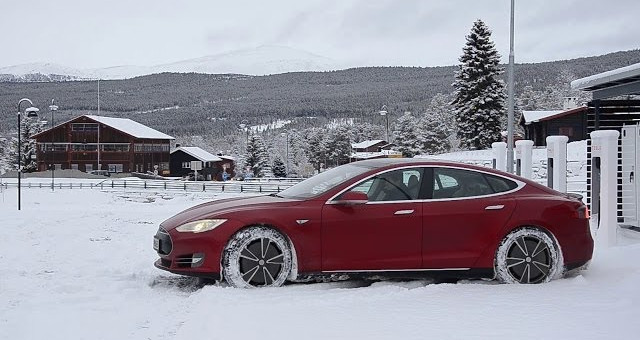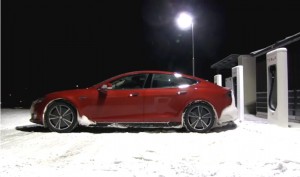News
A Norwegian Teslarati’s ownership experience
Norway sees the first delivery glitches.

 Tesla Motors is entering the Norwegian market, which has given a strong boost to its global sales in the past few months. The country, not only boasts very serious green credentials, but also has taken to electric vehicles (EV). However, not everything is peachy in Norway with Tesla, according to our Teslarati tipster.
Tesla Motors is entering the Norwegian market, which has given a strong boost to its global sales in the past few months. The country, not only boasts very serious green credentials, but also has taken to electric vehicles (EV). However, not everything is peachy in Norway with Tesla, according to our Teslarati tipster.
So far, Tesla sold over 2,200 Tesla S the first 3 months of entering the market in Norway. This makes Norway the second largest market for Tesla, and an important part of its bottom line. Tesla Motors is a new company and entering a new market is already difficult for an established carmaker, let alone for a startup. If we rave about the ways it conducts its business in the U.S., things are not as perfect in that new market. Methinks, there is something fishy in Norway!
Norwegian Teslaratipster
Our Teslaratipster found three other individuals who have the same problem, he has in a few forums in Norway. Many have to wait a very long time for the delivery of their Model S. How long? It can last 4 to 6 months. Does it remind you of anything, you early Roadster owners?
Discontent is already brewing with a few who were promised priority delivery and often get theirs later than non-priority customers. The rest, you can finger out. There is much frustration in Norway with Tesla, which is not a good thing to have for its second largest market.
To make things worse, the warranty service wildly fluctuates from customer to customer, blurring the experience even further. Some are helped right away, while others can sometime wait up to 2 months to fix problems. It gets even more complicated when you consider some buy their Model S directly, while others take out a loan, with no guarantee of having anything fixed in a timely manner. They still have to pay interest on the car that either does not work, or has faulty parts. In short, Tesla could be facing its first real, full-blown media catastrophe in Norway by not providing an equal service to all of its brand new customers and giving them the experience we rave about here in the U.S. It needs to act very fast to avert a disaster.
Warranty and quality
Norway, like many other countries, has the same problem EVs face anywhere else. Where do you charge your brand new beautiful Tesla Model S? For the majority of users, this is a huge problem and home charging on a 240 V plug can take a log time… a very long time. We know Tesla is working as quickly as it can to install Superchargers around the country. Unfortunately, the first batches of the Model S came with a few problems, such as water leaking from the panoramic roof, which makes it way in the lamps and fills cracks. This is not what you want to see in a brand new car, let alone, an electric one from a foreign startup.
Our Teslaratipster says he sent a letter to his local representative, who has to contact management in the Netherlands before any help can be received through the U.S.. This is nowhere near what we are accustomed to in the U.S.
We want to see Tesla Motors succeed, and so far, the company has done almost everything right. But is it stretching itself too thin by not having thoroughly thought out its customer service in its second largest and new market in a new country? One thing is for sure, Tesla cannot afford big mistakes. The news will be all over this and pressure will be applied in every direction. Tesla must nip this in the bud quickly.

Elon Musk
Elon Musk and Tesla AI Director share insights after empty driver seat Robotaxi rides
The executives’ unoccupied tests hint at the rapid progress of Tesla’s unsupervised Robotaxi efforts.

Tesla CEO Elon Musk and AI Director Ashok Elluswamy celebrated Christmas Eve by sharing personal experiences with Robotaxi vehicles that had no safety monitor or occupant in the driver’s seat. Musk described the system’s “perfect driving” around Austin, while Elluswamy posted video from the back seat, calling it “an amazing experience.”
The executives’ unoccupied tests hint at the rapid progress of Tesla’s unsupervised Robotaxi efforts.
Elon and Ashok’s firsthand Robotaxi insights
Prior to Musk and the Tesla AI Director’s posts, sightings of unmanned Teslas navigating public roads were widely shared on social media. One such vehicle was spotted in Austin, Texas, which Elon Musk acknowleged by stating that “Testing is underway with no occupants in the car.”
Based on his Christmas Eve post, Musk seemed to have tested an unmanned Tesla himself. “A Tesla with no safety monitor in the car and me sitting in the passenger seat took me all around Austin on Sunday with perfect driving,” Musk wrote in his post.
Elluswamy responded with a 2-minute video showing himself in the rear of an unmanned Tesla. The video featured the vehicle’s empty front seats, as well as its smooth handling through real-world traffic. He captioned his video with the words, “It’s an amazing experience!”
Towards Unsupervised operations
During an xAI Hackathon earlier this month, Elon Musk mentioned that Tesla owed be removing Safety Monitors from its Robotaxis in Austin in just three weeks. “Unsupervised is pretty much solved at this point. So there will be Tesla Robotaxis operating in Austin with no one in them. Not even anyone in the passenger seat in about three weeks,” he said. Musk echoed similar estimates at the 2025 Annual Shareholder Meeting and the Q3 2025 earnings call.
Considering the insights that were posted Musk and Elluswamy, it does appear that Tesla is working hard towards operating its Robotaxis with no safety monitors. This is quite impressive considering that the service was launched just earlier this year.
Elon Musk
Starlink passes 9 million active customers just weeks after hitting 8 million
The milestone highlights the accelerating growth of Starlink, which has now been adding over 20,000 new users per day.

SpaceX’s Starlink satellite internet service has continued its rapid global expansion, surpassing 9 million active customers just weeks after crossing the 8 million mark.
The milestone highlights the accelerating growth of Starlink, which has now been adding over 20,000 new users per day.
9 million customers
In a post on X, SpaceX stated that Starlink now serves over 9 million active users across 155 countries, territories, and markets. The company reached 8 million customers in early November, meaning it added roughly 1 million subscribers in under seven weeks, or about 21,275 new users on average per day.
“Starlink is connecting more than 9M active customers with high-speed internet across 155 countries, territories, and many other markets,” Starlink wrote in a post on its official X account. SpaceX President Gwynne Shotwell also celebrated the milestone on X. “A huge thank you to all of our customers and congrats to the Starlink team for such an incredible product,” she wrote.
That growth rate reflects both rising demand for broadband in underserved regions and Starlink’s expanding satellite constellation, which now includes more than 9,000 low-Earth-orbit satellites designed to deliver high-speed, low-latency internet worldwide.
Starlink’s momentum
Starlink’s momentum has been building up. SpaceX reported 4.6 million Starlink customers in December 2024, followed by 7 million by August 2025, and 8 million customers in November. Independent data also suggests Starlink usage is rising sharply, with Cloudflare reporting that global web traffic from Starlink users more than doubled in 2025, as noted in an Insider report.
Starlink’s momentum is increasingly tied to SpaceX’s broader financial outlook. Elon Musk has said the satellite network is “by far” the company’s largest revenue driver, and reports suggest SpaceX may be positioning itself for an initial public offering as soon as next year, with valuations estimated as high as $1.5 trillion. Musk has also suggested in the past that Starlink could have its own IPO in the future.
News
NVIDIA Director of Robotics: Tesla FSD v14 is the first AI to pass the “Physical Turing Test”
After testing FSD v14, Fan stated that his experience with FSD felt magical at first, but it soon started to feel like a routine.

NVIDIA Director of Robotics Jim Fan has praised Tesla’s Full Self-Driving (Supervised) v14 as the first AI to pass what he described as a “Physical Turing Test.”
After testing FSD v14, Fan stated that his experience with FSD felt magical at first, but it soon started to feel like a routine. And just like smartphones today, removing it now would “actively hurt.”
Jim Fan’s hands-on FSD v14 impressions
Fan, a leading researcher in embodied AI who is currently solving Physical AI at NVIDIA and spearheading the company’s Project GR00T initiative, noted that he actually was late to the Tesla game. He was, however, one of the first to try out FSD v14.
“I was very late to own a Tesla but among the earliest to try out FSD v14. It’s perhaps the first time I experience an AI that passes the Physical Turing Test: after a long day at work, you press a button, lay back, and couldn’t tell if a neural net or a human drove you home,” Fan wrote in a post on X.
Fan added: “Despite knowing exactly how robot learning works, I still find it magical watching the steering wheel turn by itself. First it feels surreal, next it becomes routine. Then, like the smartphone, taking it away actively hurts. This is how humanity gets rewired and glued to god-like technologies.”
The Physical Turing Test
The original Turing Test was conceived by Alan Turing in 1950, and it was aimed at determining if a machine could exhibit behavior that is equivalent to or indistinguishable from a human. By focusing on text-based conversations, the original Turing Test set a high bar for natural language processing and machine learning.
This test has been passed by today’s large language models. However, the capability to converse in a humanlike manner is a completely different challenge from performing real-world problem-solving or physical interactions. Thus, Fan introduced the Physical Turing Test, which challenges AI systems to demonstrate intelligence through physical actions.
Based on Fan’s comments, Tesla has demonstrated these intelligent physical actions with FSD v14. Elon Musk agreed with the NVIDIA executive, stating in a post on X that with FSD v14, “you can sense the sentience maturing.” Musk also praised Tesla AI, calling it the best “real-world AI” today.









